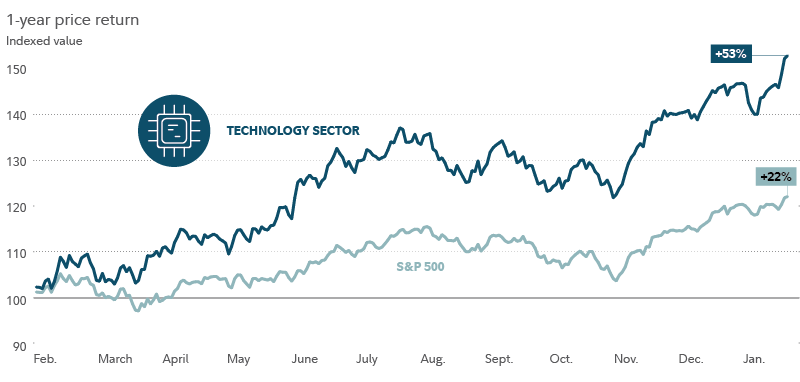The technology sector has had an outstanding past year. A shifting macroeconomic environment in 2023 helped bring tech stocks back into favor with investors. The resulting rally was further fueled by groundbreaking advancements in artificial intelligence (AI), which heralded the possibility of a promising new era of innovation for the sector.
This year, tech’s performance will of course depend, to some extent, on the macro environment. But for investors more focused on the long term, trends like the development and adoption of AI, continued digitization, and the move to the cloud, have the potential to drive growth for the sector for years to come.
Tech has entered a new era
The past year was a humbling reminder of how much market conditions can shift in a year. A year ago, tech was coming off a year of double-digit losses, which had some investors wondering if the sector’s best days were behind it. Tech sector performance can be heavily influenced by interest-rate policy—more so than some other sectors. The aggressiveness of the Fed’s rate-hiking cycle, plus the stubbornness of inflation for many months, had depressed many tech stocks by the start of 2023.
But last year brought a change in the winds. As inflation cooled, the end of the Fed’s rate-hiking cycle seemed to come into view, which helped spur relief rallies. Investor preferences shifted strongly in favor of tech stocks again—as the splash of ChatGPT’s launch was followed by surging results at some AI-related firms. Tech closed 2023 as the top performer among all market sectors, and as of late January was continuing to outperform the S&P 500® in 2024.

For this year and beyond, AI is clearly not the only big trend driving the sector, but it is perhaps one of the most potentially transformative ones. That said, for investors, the key may be not just to follow the trend, but to identify the various stages of AI adoption that may play out, and to identify timely opportunities at attractive valuations along the way.
Putting the rise of AI into context
Since the arrival of the chatbot ChatGPT in November 2022, practically every company and every boardroom, across virtually every industry, has been discussing how to embrace large language models used by generative-AI applications—the kinds of models that can generate high-quality text, images, and other content. Potential anticipated benefits have been cited as increased productivity, personalized customer experiences, accelerated research and development, and an expanded range of feasible business models.
There is clearly a lot of discussion, publicity and, at this stage, even hype around generative AI. I believe generative AI has the potential to be transformative in the long run. However, because of its complexities—which include identifying use cases, and building and training models—generative AI likely will not be able to deliver these benefits overnight. Rather, it may take many years for most enterprises to implement AI into their workflow.
Timing, specifically having the right timing, matters in investing, and I expect there could be several phases in the course of AI adoption that offer investors timely opportunities. Although innovation is happening rapidly—almost daily, along with potential regulatory oversight—the current phase of AI is centered around “picks and shovels,” meaning building out the overall infrastructure needed to develop and adopt AI. Later stages of development may move to productivity applications serving different end markets.
Semiconductors have continued to look attractive
In looking for such pick-and-shovel companies, I have found opportunity among semiconductor companies. For example, Nvidia (
Fund top holdings1
Top-10 holdings of the Fidelity® Select Technology Portfolio (
- 18.8% – Microsoft Corp. (
) - 15.6% – Apple Inc. (
) - 13.4% – Nvidia Corp. (
) - 4.4% – NXP Semiconductors N.V. (
) - 4.2% – Marvell Technology Inc. (
) - 4.2% – ON Semiconductor Corp. (
) - 4.0% – ServiceNow Inc. (
) - 3.7% – Salesforce Inc. (
) - 3.5% – Cisco Systems Inc. (
) - 3.4% – Okta Inc. (
)
(See the most recent fund information.)
Marvell Technology (
In addition to the tailwinds from AI, semiconductors have seen advantages from a number of other recent trends. Geopolitical tensions have been fueling a focus on boosting semiconductor supply chains. And chips are key enablers of the shift to electric vehicles and driver-assistance systems. Against this backdrop, semiconductor stocks have recently had a sizeable overweight in the fund.
Cloud spotting
Increased adoption of cloud computing was already a major trend before the recent developments in AI. Companies have been increasingly moving their workloads to the cloud, a trend that might only accelerate as companies work to put in place the infrastructure they’ll need to employ AI.
Companies that offer cloud-based software, that already have large installed bases, and that are working to adopt AI, could be potential beneficiaries if these trends continue. For example, ServiceNow (
A strong long-term outlook
As 2024 takes shape, the macroeconomic outlook remains unclear, with recession still a possibility. However, as a sector portfolio manager I focus on the long term, including trying to identify which companies could see the greatest boosts to long-term growth from emerging innovations and trends.
These trends could be temporarily slowed if a recession were to finally hit this year. But I believe they may provide a tailwind for certain companies in this sector for years to come. And although the best growth stories often trade at a premium to the market, I focus on companies where I believe future growth is not reflected in the current share price. I am excited to see where some of these growth stories take us.

Adam Benjamin is a research analyst and portfolio manager in the Equity division at Fidelity Investments.
Mr. Benjamin manages the Fidelity Advisor Technology Fund, Fidelity VIP Technology Portfolio, Fidelity Select Semiconductors Portfolio, Fidelity Select Technology Fund, Fidelity Advisor Semiconductors Fund and the information technology sleeves of the Fidelity Institutional Asset Management (FIAM) Large Cap Core and Global Core sector strategies. He also covers the large cap semiconductors industry.
Prior to assuming his current roles, Mr. Benjamin was a research analyst responsible for the coverage of the semiconductor, semiconductor capital equipment, and solar end markets. Most recently he served as global technology sector leader within FIAM.
Before joining Fidelity in 2011, Mr. Benjamin served as managing director and head of semiconductor equity research at Jefferies & Company, Inc. Previously, he held various roles at SG Cowen, including senior research associate focused on the semiconductor space and vice president in the Technology M&A group. Mr. Benjamin was also an associate in the Corporate Law department of Sullivan & Worcester. He has been following the technology sector for over 18 years.
Mr. Benjamin earned his bachelor of arts degree from Cornell University and his juris doctor degree, cum laude, from Suffolk University Law School.



